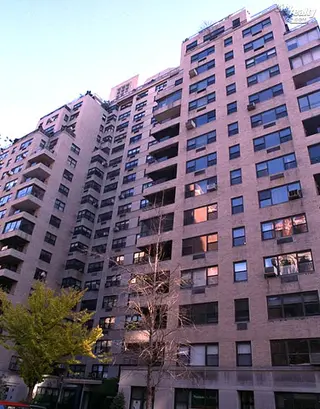 Carter Horsley
Carter HorsleyDec 23, 2011
Carter's Review
Centrally located on the Gold Coast of Greenwich Village, The Brevoort is one of the city's most sought-after post-war cooperatives. Amenities in this pet-friendly elevator building include a 24-hour doorman, concierge services, resident manager, a grand lobby with landscaped gardens, a gym, resident lounge/meeting room, parking garage, bike room, and a laundry room. The Brevoort is one of few buildings in NYC to have a co-generator to ensure full service.
The building features eco-friendly initiatives including new windows, upgraded electrical, and more.
Lower Fifth Avenue changed dramatically after World War I as high-rise buildings began to replace many of the former mansions of some of the city's most illustrious citizens who were moving north.
The first move was highlighted by the apartment tower at One Fifth Avenue, a new landmark because of its height for the area and Greenwich Village and it was followed by several attractive mid-rise apartment houses.
The second change occurred in the early 1950's when the first major postwar apartment buildings began to transform the area in the era before the creation of the city's Landmarks Preservation Commission.
This period was highlighted by the construction of 2 Fifth Avenue, but also heavily accented, a couple of years later, by this building, which was formerly occupied by the Brevoort Hotel, one of the neighborhood's most famous gathering spots in years gone by.
Built in 1956, this 19-story building has 296 apartments that were converted to cooperatives in 1981.
The light-colored, glazed brick building is quite attractive of its kind with its recessed tower and landscaped driveway.
The project is named after the hotel that occupied its site that was named after one of the oldest and most famous Dutch families in New York.
In 1714, Kate Simon wrote in her book, "Fifth Avenue, A Very Social History," (Harcourt Brace & Jovanovich, 1978), Henrick Van Brevoort "acquired for the sum of four hundred pounds land that straddled Fifth Avenue for a short distance and ran eastward to the Bowery and then took a long stretch northward."
"The family," she continued, "sold portions off at great profit, holding on a to a section below Eleventh Street where they meant to stay. A later Henry Brevoort, of the 1840's, guarded his farm, his kitchen gardens, his pet bear and his tavern with high passions. Behind a blunderbuss he refused tolet the city drive Eleventh Street through his land for access to the new Grace Church, in spite of the fact that the architect was esteemed James Renwick and a relative...
"Another Henry Brevoort built a spectacular house at 24 Fifth Avenue (Ninth Street) in 1834 with the proceeds of Wall Street investments based on real estate sales. The house was almost square in a faintly Palladian manner, the doorway supported by fluted columns, the roof ornamented with runs of Greek key, the spacious rooms introduced by a graceful stairway. It was in these rooms that a masked ball was held which put a halt, for a time, to this form of "continental" entertainment. One of the guests was Miss Matilda Barclay, the daughter of the British consul; another was the young man she loved, a Southern gallant, all manner and little substance, of whom Matty's parents did not approve. The masked lovers stole away and were married early in the morning of the ball. Masked balls were obviously hazardous and it was decreed that anyone who offered such divertissements would be fined one thousand dollars, the fine reduced to five hundred dollars if a host confessed to having staged such an entertainment and avowed he was very sorry. It was inevitable that the confession fee would be collected among friends in advance of the balls, a system that evolved as subscriptions.
"Always in the forefront of fashion, it might easily have been the Brevoorts who first served dinner in the newfangled, disconcerting French style where, instead of the usual everything-out spread, like an indoor picnic, the table bore only ornaments when one sat down....The Brevoorts were also the first family to allow a report - a reporter of the scandalous Herald at that - to witness a ball.
"Four years after Henry Brevoort sold his house to Henry de Rham, the Hotel Brevoort opened on this site and was described by Kate Simon as "especially hospitable to English ships' captains who might influence custom its way." The Cafe Brevoort became a popular restaurant and nightclub and Simon recounted that its "wake on the last night before Prohibition set in was a memorable Saturnalia, or at least remembered so by misty participants," adding that "all the liquor in the Brevoort cellars was brought up and sold to the guests at nonprofit prices."
The building occupies almost half its entire block and many revelers from the old Cafe Brevoort probably wandered eventually into the Cedar Tavern that became the famous hang-out of the Abstract Expressionists until its building was torn down to make way for an annex to this building known as the Brevoort East at 20 East Ninth Street.In a city where the names of residential buildings usually have no historical connection to the site, it is pleasing that this building, which has large, modern apartments, paid proper homage to its history.

- Co-op built in 1956
- 2 apartments currently for sale ($2.395M to $2.895M)
- Located in Greenwich Village
- 296 total apartments 296 total apartments
- 10 recent sales ($675K to $2.8M)
- Doorman
- Pets not Allowed

 6sqft delivers the latest on real estate, architecture, and design, straight from New York City.
6sqft delivers the latest on real estate, architecture, and design, straight from New York City.
